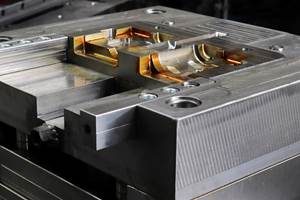Laser Engraving Enhances Mold Design
Consideration should always be given to the optimum cost/quality relationship when choosing laser engraving.
When ITW Deltar (Frankfort, IL), a Tier 1 supplier to the automotive market, approached Creative Die Mold Corp. (Glendale Heights, IL) to build a fuel shield, some interesting challenges were discovered. The shield required a part number, material specification and a date wheel - all engraved on a surface that was angled 65 degrees from the parting line. The P/N and material specification were to be put directly on the tool, while the date wheel required a separate pin. To add to the difficulty, the copy was to be read undistorted while viewed from line of draw (or top view). This meant that the copy had to be severely distorted to compensate for the sidewall application. A pantograph solution was not possible due to the sidewall access, and acid etched copy would not have followed the line of draw.
 |
| New laser technology can achieve detail never before seen. |
Bruce Singer, the tooling manager at Creative Die, discovered that the only solution available was to digitally manipulate the artwork and import that data to the Yag Laser. The tool was tilted to meet the line of draw, and the laser went to work. The engraved copy on the tool appears severely distorted. However, when the fuel shield is installed on the vehicle, the engraving is seen without distortion by the user.
This new laser technology also can achieve detail never before seen. Characters as small as .008" in height can be achieved with no compromise in detail or readability. Depths achieved can range from .0002" to .100" deep, depending on the application. Engravings historically relegated to the "acid etch" process, such as sidewall or restricted areas - deep pockets, rib areas or up against standing details - can now be engraved without the limitations of acid etching, such as depth restrictions, fuzzy edges or leak/stain possibilities. As long as the beam can "see" the desired surface without obstruction, laser engraving is now the superior method. A natural draft angle of six to seven degrees per side is achieved, but can be manipulated to larger draft angles with 3-D programming. Finishes at the bottom of the engravings are typically equal to a fine EDM finish, but also can be programmed to result in a finer or rougher finish.
Lightly contoured surfaces can be laser engraved as successfully as flat surfaces, while greater contours can be done by segmenting the copy into smaller sections. The laser engineer then programs a focal point for the laser to tie the sections together without a witness line.
The Yag Laser, coupled with state-of-the-art software, is truly a quantum leap forward for engraving technology as illustrated by the additional benefits listed below:
- Cost savings with multiple cavity or insert applications.
- Electrode fabrication (the laser is a "vibration-less" operation).
- True replication of CAD or graphics files, or camera-ready artwork.
- Engraving speed.
- Reduced costs (in most cases).
- Superior quality and consistency.
- Unattended machining capabilities.
- "Mark-on" ability (the laser can be programmed to remove only permanent marker or dykem materials prior to metal removal to verify proper location).
- No templates or patterns required.
Each application should be individually considered to determine the optimum cost/ quality relationship, as well as specific customer requirements.
Related Content
How to Use Diffusion Bonding to Optimize a Mold’s Thermal Performance
Joining dissimilar metals has tremendous potential for conformal cooling, but to successfully use diffusion bonding, a mold builder must understand the complexities of the interface and its effect on the chemical and thermo-mechanical properties of the bond.
Read MorePrecision Welding Services Offer Rapid Turnaround Mold Repair and Reduced Molder Downtime
X-Cell Tool & Mold relies on outsourced, high-quality welding repairs from Lewis-Bawol Welding to ensure its customers' molds are back in production quickly and affordably.
Read MoreQuestions and Considerations Before Sending Your Mold Out for Service
Communication is essential for proper polishing, hot runner manifold cleaning, mold repair, laser engraving and laser welding services.
Read MoreThe Ins and Outs of Hot Runner Temperature Control
A training checklist that explains the why and how of proper hot runner temperature control and system management.
Read MoreRead Next
Reasons to Use Fiber Lasers for Mold Cleaning
Fiber lasers offer a simplicity, speed, control and portability, minimizing mold cleaning risks.
Read MoreHow to Use Strategic Planning Tools, Data to Manage the Human Side of Business
Q&A with Marion Wells, MMT EAB member and founder of Human Asset Management.
Read More






_300x250 4.png;maxWidth=300;quality=90)









.jpg;maxWidth=300;quality=90)






